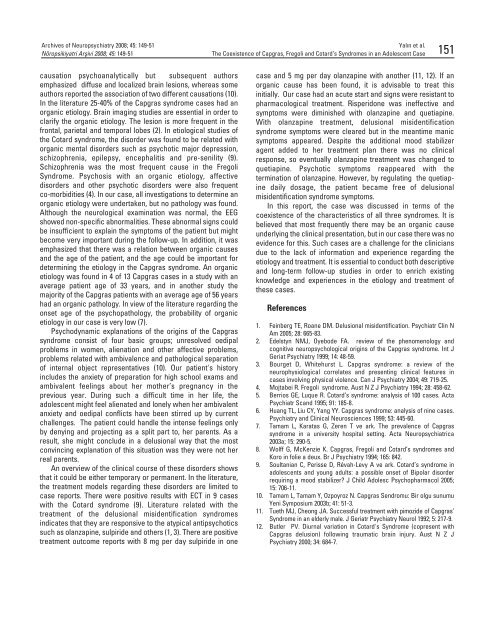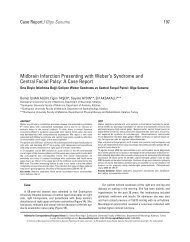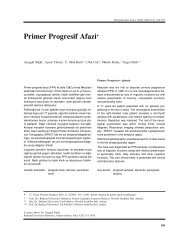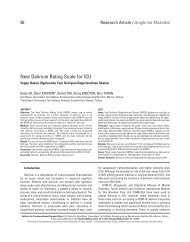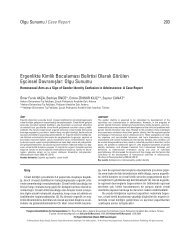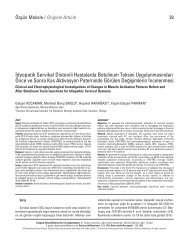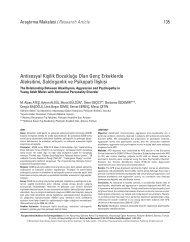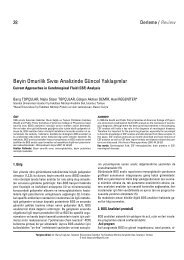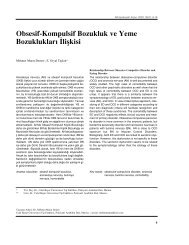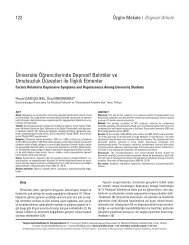The Coexistence of Capgras, Fregoli and Cotard's Syndromes in an ...
The Coexistence of Capgras, Fregoli and Cotard's Syndromes in an ...
The Coexistence of Capgras, Fregoli and Cotard's Syndromes in an ...
You also want an ePaper? Increase the reach of your titles
YUMPU automatically turns print PDFs into web optimized ePapers that Google loves.
Archives <strong>of</strong> Neuropsychiatry 2008; 45: 149-51Nöropsikiyatri Arflivi 2008; 45: 149-51Yal›n et al.<strong>The</strong> <strong>Coexistence</strong> <strong>of</strong> <strong>Capgras</strong>, <strong>Fregoli</strong> <strong><strong>an</strong>d</strong> Cotard’s <strong>Syndromes</strong> <strong>in</strong> <strong>an</strong> Adolescent Case 151causation psycho<strong>an</strong>alytically but subsequent authorsemphasized diffuse <strong><strong>an</strong>d</strong> localized bra<strong>in</strong> lesions, whereas someauthors reported the association <strong>of</strong> two different causations (10).In the literature 25-40% <strong>of</strong> the <strong>Capgras</strong> syndrome cases had <strong>an</strong>org<strong>an</strong>ic etiology. Bra<strong>in</strong> imag<strong>in</strong>g studies are essential <strong>in</strong> order toclarify the org<strong>an</strong>ic etiology. <strong>The</strong> lesion is more frequent <strong>in</strong> thefrontal, parietal <strong><strong>an</strong>d</strong> temporal lobes (2). In etiological studies <strong>of</strong>the Cotard syndrome, the disorder was found to be related withorg<strong>an</strong>ic mental disorders such as psychotic major depression,schizophrenia, epilepsy, encephalitis <strong><strong>an</strong>d</strong> pre-senility (9).Schizophrenia was the most frequent cause <strong>in</strong> the <strong>Fregoli</strong>Syndrome. Psychosis with <strong>an</strong> org<strong>an</strong>ic etiology, affectivedisorders <strong><strong>an</strong>d</strong> other psychotic disorders were also frequentco-morbidities (4). In our case, all <strong>in</strong>vestigations to determ<strong>in</strong>e <strong>an</strong>org<strong>an</strong>ic etiology were undertaken, but no pathology was found.Although the neurological exam<strong>in</strong>ation was normal, the EEGshowed non-specific abnormalities. <strong>The</strong>se abnormal signs couldbe <strong>in</strong>sufficient to expla<strong>in</strong> the symptoms <strong>of</strong> the patient but mightbecome very import<strong>an</strong>t dur<strong>in</strong>g the follow-up. In addition, it wasemphasized that there was a relation between org<strong>an</strong>ic causes<strong><strong>an</strong>d</strong> the age <strong>of</strong> the patient, <strong><strong>an</strong>d</strong> the age could be import<strong>an</strong>t fordeterm<strong>in</strong><strong>in</strong>g the etiology <strong>in</strong> the <strong>Capgras</strong> syndrome. An org<strong>an</strong>icetiology was found <strong>in</strong> 4 <strong>of</strong> 13 <strong>Capgras</strong> cases <strong>in</strong> a study with <strong>an</strong>average patient age <strong>of</strong> 33 years, <strong><strong>an</strong>d</strong> <strong>in</strong> <strong>an</strong>other study themajority <strong>of</strong> the <strong>Capgras</strong> patients with <strong>an</strong> average age <strong>of</strong> 56 yearshad <strong>an</strong> org<strong>an</strong>ic pathology. In view <strong>of</strong> the literature regard<strong>in</strong>g theonset age <strong>of</strong> the psychopathology, the probability <strong>of</strong> org<strong>an</strong>icetiology <strong>in</strong> our case is very low (7).Psychodynamic expl<strong>an</strong>ations <strong>of</strong> the orig<strong>in</strong>s <strong>of</strong> the <strong>Capgras</strong>syndrome consist <strong>of</strong> four basic groups; unresolved oedipalproblems <strong>in</strong> women, alienation <strong><strong>an</strong>d</strong> other affective problems,problems related with ambivalence <strong><strong>an</strong>d</strong> pathological separation<strong>of</strong> <strong>in</strong>ternal object representatives (10). Our patient's history<strong>in</strong>cludes the <strong>an</strong>xiety <strong>of</strong> preparation for high school exams <strong><strong>an</strong>d</strong>ambivalent feel<strong>in</strong>gs about her mother’s pregn<strong>an</strong>cy <strong>in</strong> theprevious year. Dur<strong>in</strong>g such a difficult time <strong>in</strong> her life, theadolescent might feel alienated <strong><strong>an</strong>d</strong> lonely when her ambivalent<strong>an</strong>xiety <strong><strong>an</strong>d</strong> oedipal conflicts have been stirred up by currentchallenges. <strong>The</strong> patient could h<strong><strong>an</strong>d</strong>le the <strong>in</strong>tense feel<strong>in</strong>gs onlyby deny<strong>in</strong>g <strong><strong>an</strong>d</strong> project<strong>in</strong>g as a split part to, her parents. As aresult, she might conclude <strong>in</strong> a delusional way that the mostconv<strong>in</strong>c<strong>in</strong>g expl<strong>an</strong>ation <strong>of</strong> this situation was they were not herreal parents.An overview <strong>of</strong> the cl<strong>in</strong>ical course <strong>of</strong> these disorders showsthat it could be either temporary or perm<strong>an</strong>ent. In the literature,the treatment models regard<strong>in</strong>g these disorders are limited tocase reports. <strong>The</strong>re were positive results with ECT <strong>in</strong> 9 caseswith the Cotard syndrome (9). Literature related with thetreatment <strong>of</strong> the delusional misidentification syndromes<strong>in</strong>dicates that they are responsive to the atypical <strong>an</strong>tipsychoticssuch as ol<strong>an</strong>zap<strong>in</strong>e, sulpiride <strong><strong>an</strong>d</strong> others (1, 3). <strong>The</strong>re are positivetreatment outcome reports with 8 mg per day sulpiride <strong>in</strong> onecase <strong><strong>an</strong>d</strong> 5 mg per day ol<strong>an</strong>zap<strong>in</strong>e with <strong>an</strong>other (11, 12). If <strong>an</strong>org<strong>an</strong>ic cause has been found, it is advisable to treat this<strong>in</strong>itially. Our case had <strong>an</strong> acute start <strong><strong>an</strong>d</strong> signs were resist<strong>an</strong>t topharmacological treatment. Risperidone was <strong>in</strong>effective <strong><strong>an</strong>d</strong>symptoms were dim<strong>in</strong>ished with ol<strong>an</strong>zap<strong>in</strong>e <strong><strong>an</strong>d</strong> quetiap<strong>in</strong>e.With ol<strong>an</strong>zap<strong>in</strong>e treatment, delusional misidentificationsyndrome symptoms were cleared but <strong>in</strong> the me<strong>an</strong>time m<strong>an</strong>icsymptoms appeared. Despite the additional mood stabilizeragent added to her treatment pl<strong>an</strong> there was no cl<strong>in</strong>icalresponse, so eventually ol<strong>an</strong>zap<strong>in</strong>e treatment was ch<strong>an</strong>ged toquetiap<strong>in</strong>e. Psychotic symptoms reappeared with theterm<strong>in</strong>ation <strong>of</strong> ol<strong>an</strong>zap<strong>in</strong>e. However, by regulat<strong>in</strong>g the quetiap<strong>in</strong>edaily dosage, the patient became free <strong>of</strong> delusionalmisidentification syndrome symptoms.In this report, the case was discussed <strong>in</strong> terms <strong>of</strong> thecoexistence <strong>of</strong> the characteristics <strong>of</strong> all three syndromes. It isbelieved that most frequently there may be <strong>an</strong> org<strong>an</strong>ic causeunderly<strong>in</strong>g the cl<strong>in</strong>ical presentation, but <strong>in</strong> our case there was noevidence for this. Such cases are a challenge for the cl<strong>in</strong>ici<strong>an</strong>sdue to the lack <strong>of</strong> <strong>in</strong>formation <strong><strong>an</strong>d</strong> experience regard<strong>in</strong>g theetiology <strong><strong>an</strong>d</strong> treatment. It is essential to conduct both descriptive<strong><strong>an</strong>d</strong> long-term follow-up studies <strong>in</strong> order to enrich exist<strong>in</strong>gknowledge <strong><strong>an</strong>d</strong> experiences <strong>in</strong> the etiology <strong><strong>an</strong>d</strong> treatment <strong>of</strong>these cases.References1. Fe<strong>in</strong>berg TE, Ro<strong>an</strong>e DM. Delusional misidentification. Psychiatr Cl<strong>in</strong> NAm 2005; 28: 665-83.2. Edelstyn NMJ, Oyebode FA. review <strong>of</strong> the phenomenology <strong><strong>an</strong>d</strong>cognitive neuropsychological orig<strong>in</strong>s <strong>of</strong> the <strong>Capgras</strong> syndrome. Int JGeriat Psychiatry 1999; 14: 48-59.3. Bourget D, Whitehurst L. <strong>Capgras</strong> syndrome: a review <strong>of</strong> theneurophysiological correlates <strong><strong>an</strong>d</strong> present<strong>in</strong>g cl<strong>in</strong>ical features <strong>in</strong>cases <strong>in</strong>volv<strong>in</strong>g physical violence. C<strong>an</strong> J Psychiatry 2004; 49: 719-25.4. Mojtabei R. <strong>Fregoli</strong> syndrome. Aust N Z J Psychiatry 1994; 28: 458-62.5. Berrios GE, Luque R. Cotard’s syndrome: <strong>an</strong>alysis <strong>of</strong> 100 cases. ActaPsychiatr Sc<strong><strong>an</strong>d</strong> 1995; 91: 185-8.6. Hu<strong>an</strong>g TL, Liu CY, Y<strong>an</strong>g YY. <strong>Capgras</strong> syndrome: <strong>an</strong>alysis <strong>of</strong> n<strong>in</strong>e cases.Psychiatry <strong><strong>an</strong>d</strong> Cl<strong>in</strong>ical Neurosciences 1999; 53: 445-60.7. Tamam L, Karatas G, Zeren T ve ark. <strong>The</strong> prevalence <strong>of</strong> <strong>Capgras</strong>syndrome <strong>in</strong> a university hospital sett<strong>in</strong>g. Acta Neuropsychiatrica2003a; 15: 290-5.8. Wolff G, McKenzie K. <strong>Capgras</strong>, <strong>Fregoli</strong> <strong><strong>an</strong>d</strong> Cotard’s syndromes <strong><strong>an</strong>d</strong>Koro <strong>in</strong> folie a deux. Br J Psychiatry 1994; 165: 842.9. Soult<strong>an</strong>i<strong>an</strong> C, Perisse D, Révah-Levy A ve ark. Cotard’s syndrome <strong>in</strong>adolescents <strong><strong>an</strong>d</strong> young adults: a possible onset <strong>of</strong> Bipolar disorderrequir<strong>in</strong>g a mood stabilizer? J Child Adolesc Psychopharmacol 2005;15: 706-11.10. Tamam L, Tamam Y, Ozpoyroz N. <strong>Capgras</strong> Sendromu: Bir olgu sunumuYeni Symposium 2003b; 41: 51-3.11. Tueth MJ, Cheong JA. Successful treatment with pimozide <strong>of</strong> <strong>Capgras</strong>’Syndrome <strong>in</strong> <strong>an</strong> elderly male. J Geriatr Psychiatry Neurol 1992; 5: 217-9.12. Butler PV. Diurnal variation <strong>in</strong> <strong>Cotard's</strong> Syndrome (copresent with<strong>Capgras</strong> delusion) follow<strong>in</strong>g traumatic bra<strong>in</strong> <strong>in</strong>jury. Aust N Z JPsychiatry 2000; 34: 684-7.


